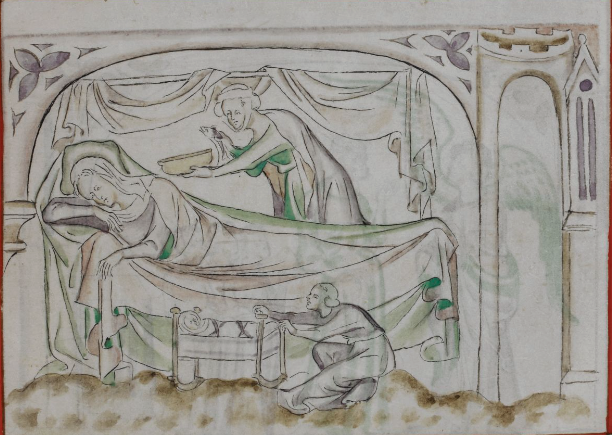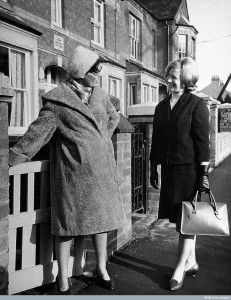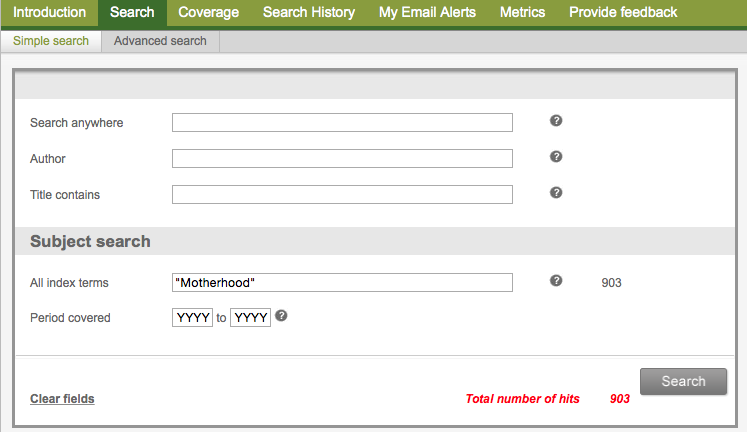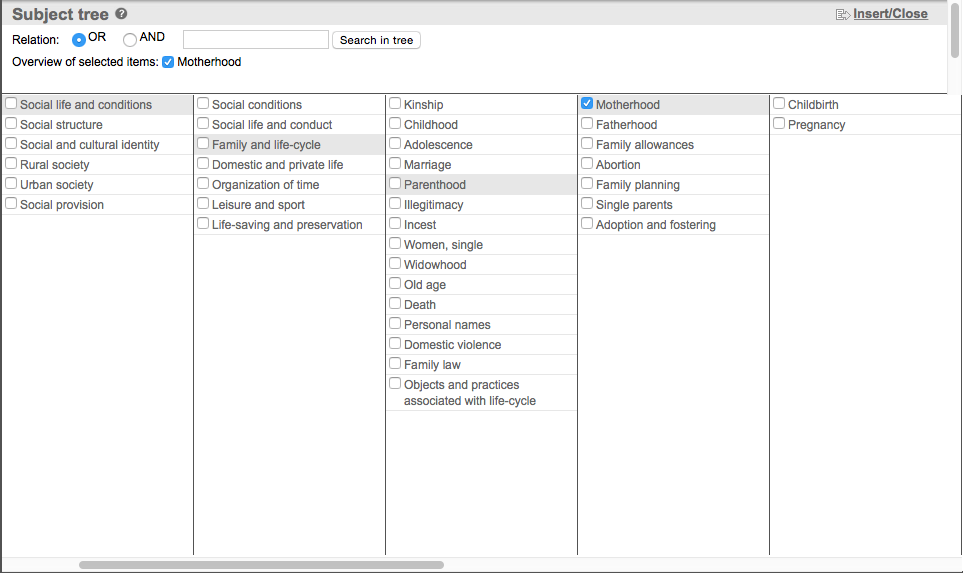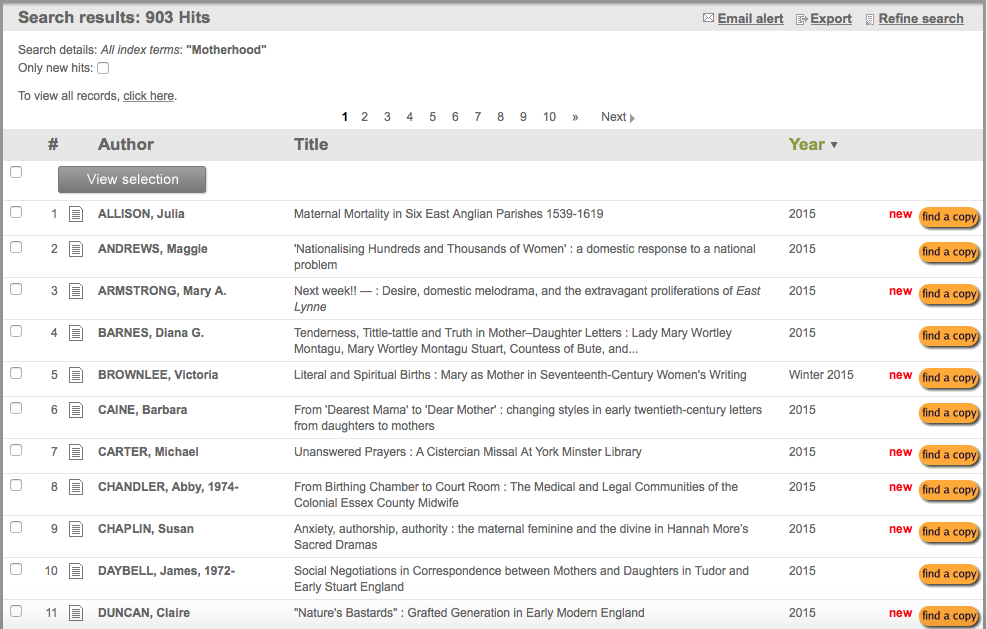As spring is traditionally the season associated with new life and fertility after the long winter months, now seems a timely moment to explore the latest academic publications on the subject of Motherhood featured in the Bibliography of British and Irish History. The vast majority of material produced recently on this topic covers the Tudor and early modern period, but the first resource presented here, Performative Rituals for Conception and Childbirth in England, 900–1500 concerns the medieval period.
Birth and death took central stage in medieval life and thought, and the practice of rituals for conception and safe pregnancy highlight a maternal (and paternal) concern that is easily understood today. The rituals range from verbal charms and religious benedictions (a popular charm was the peperit charm, that invoked the Holy Mothers of Mary and Elizabeth), to ingesting words written in cheese or butter, or placing physical objects upon the body. There is evidence that manuscripts were used as ‘birthing girdles’, wrapped around a woman’s midriff during pregnancy and possibly even labour, as can be seen in the manuscript Wellcome MS. 632. Most of these practices were largely in the female domain, but the article also includes medical charms advised by medieval surgeons and mendicant friars. The rituals highlight a medieval belief in the power of the spoken word, through incantations and charms; and the written word, through the haptic relationship between manuscripts and the body.
Moving away from the medieval period, there are two resources covering Tudor queens: Regarding Catherine of Aragon and Unanswered Prayers : A Cistercian Missal At York Minster Library. The first examines the life of Catherine, a women with a complex cultural heritage whose legacy as queen of England has rarely been scrutinised, yet strongly influenced the reign of both Mary and Elizabeth. The relationships between her mother, Isabella I of Spain, mother-in-law Elizabeth of York, and great mother-in-law Margaret Beaufort are also discussed, in terms of how their roles as ‘queen-as-mother’ impacted on Catherine’s public and private persona. The second resource discusses a manuscript containing handwritten Latin prayers for the safe pregnancy of Mary I, divided into three sections, oratio, secreta and postcommunio. The prayers were almost certainly disseminated from a printed book now held at Lambeth Palace Library. This dates the prayers from late 1554, when Mary was assumed to be pregnant with Philip of Spain’s child, and stands as a sad reminder of Mary’s (and catholic England’s) anticipation of a child that never came.
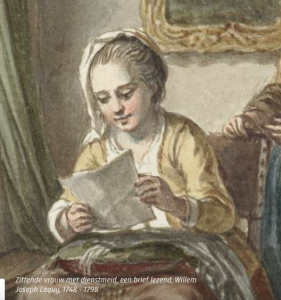
Detail from Zittende vrouw met dienstmeid, een brief lezend, Willem Joseph Laquy, 1748 – 1798, Rijksmuseum
A special issue of Women’s History Review features an article titled Social Negotiations in Correspondence between Mothers and Daughters in Tudor and Early Stuart England, examining mother-daughter relationships within the strict social confines of epistolary etiquette. These letters offer an intriguing glimpse into the social realities of the sixteenth and seventeenth century, with many offering maternal advice on specific situations regarding childbirth, marriage and inheritance. Interestingly, more letters from daughters than mothers survive, which may indicate that a mother’s advice is always much sought after! However, this article demonstrates that letters could also convey anger, and daughters could make their opinions perfectly clear, managing to defend their honour whilst still portraying the appropriate respect, through the templates provided in letter-writing manuals. The same journal issue also features From ‘Dearest Mama’ to ‘Dear Mother’ : changing styles in early twentieth-century letters from daughters to mothers, examining how letter writing changed in one generation, by looking at the correspondence between two members of the Strachey family, Philippa Strachey and her niece Elinor Rendel, written home to their mothers whilst travelling. Both articles reflect the social etiquette of their time, whilst underlining the importance of the mother-daughter bond.
As migration to America increased during the seventeenth and eighteenth centuries, the article From Birthing Chamber to Court Room: The Medical and Legal Communities of the Colonial Essex County Midwife draws attention to the issue of children born out of wedlock. Debunking the view that early modern midwives were regarded with suspicion and open to accusations of witchcraft, evidence from court records show that they held a respected position in the community. When attending the birth of an unmarried woman, it was their duty to repeatedly pressure the labouring woman to reveal the name of the father of the child. If successful, the midwife would then provide evidence in court against the accused father, with the authority of her statement seemingly being revered above all else. The calling to account of these men seems to stem from a worry that an economically fragile community would have to support these children born out of wedlock, rather than a sense of morality; although harsh punishments were meted out to both mother and father, in the form of fines or whippings. To bookend this article, Maternal Mortality in Six East Anglian Parishes, 1539-1619 examines the outcomes of a cross-section of women who gave birth in Essex, Suffolk and Norfolk and subsequently died, focussing on their community and social status, as well as the implications of multiple births, stillbirths and illegitimacy. Again, the role of midwives as respected and vital members of the community is highlighted, and the unwillingness of a parish to support an illegitimate child chimes with the previous article.

Nativity of the Virgin, London, British Library, Harley 629, f. 1v
On a more spiritual theme, Literal and Spiritual Births : Mary as Mother in Seventeenth-Century Women’s Writing discusses how two Reformation women, Aemilia Lanyer and Dorothy Leigh, elevated Mary as not only the mother of God, but the deliverer of God’s plan for salvation, and therefore created a new metaphysical construction for maternity. A chapter in British Women and the Intellectual World in the Long Eighteenth Century titled Anxiety, Authorship, Authority : the Maternal Feminine and the Divine in Hannah More’s Sacred Dramas again challenges the notion of the feminine, albeit at times as an outright rejection of the maternal image. Hannah More, an eighteenth century writer and philanthropist, wrote her Sacred Dramas in 1782, and they can be interpreted as a revisioning of women in an era of patriarchal tradition. The dramatically titled Next week!! — : Desire, Domestic Melodrama, and the Extravagant Proliferations of East Lynne examines the Victorian novel East Lynne by Ellen Wood, and discusses the didactic message in the narrative that nineteenth-century wives and mothers should be satisfied with their domestic situation, however dull and stifling that may be.
Returning to more practical themes, Risky or Relaxing? Exercise during Pregnancy in Britain, c.1930–1960 investigates how physical activity gained popularity in the mid-twentieth century, and helped to overthrow the previous generation’s idea that pregnant women should be passive in their antenatal months. Love Beyond the Frame : Stories of Maternal Love Outside Marriage in the 1950s and 1960s gives an account of twenty women who raised children single-handed in the postwar decades, focusing on real issues such as housing and employment. The women who provided the oral testimonies were predominantly working class, and reflect the material hardships of the era, despite changing social values.
From the broad spectrum of resources above, the term ‘Motherhood’ embraces the themes of fertility, queenship, spirituality and economic realities. Search on the Bibliography of British and Irish History to discover more – try a simple subject search for ‘Motherhood’ (fig. 1), or use the subject tree on the advanced search to really drill down (fig. 2):
There is also a helpful video tutorial on using the Subject tree.

